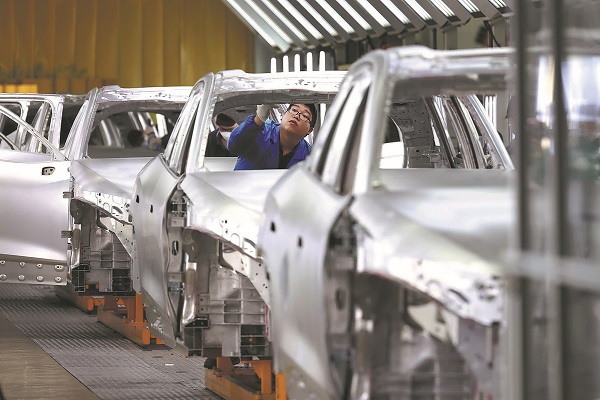Emerging manufacturing powers Anhui's rise

Employees work on a production line of new energy vehicles at NIO's plant in Hefei, Anhui province, in August 2022. [XIE CHEN/FOR CHINA DAILY]
Province in East China grows with good potential in H1 on complete industrial chain
Anhui, a province in East China, saw robust economic recovery in the first half, which business leaders and experts attributed to its comprehensive industrial chain and solid base for new manufacturing sectors in recent years.
The Fifth Plenary Session of the 11th Anhui Provincial Committee of the Communist Party of China, which concluded on Wednesday, vowed to further consolidate the province's 10 strategic emerging industries, with the new energy vehicle sector being the most important one.
Over the first six months, Anhui produced nearly 1.03 million automobiles, a year-on-year growth of 43.6 percent. The province manufactured 342,000 NEVs in the period, about 9 percent of the country's total NEV output, according to a press conference on Thursday.
"Since the beginning of this year, Anhui's economy has experienced a relatively fast recovery, particularly the growth of industries above designated scale (with major business revenue above 20 million yuan) and new manufacturing," said Liu Baokui, director of the Regional Strategic Research Center of the National Development and Reform Commission, the country's top economic regulator.
"This has demonstrated the resilience and recovery capability of the local economy, with businesses in emerging manufacturing, particularly new energy, integrated circuits and artificial intelligence underpinning growth," Liu said.
This industrial landscape has made local growth both quick and sustainable, he added.
By the end of 2022, the province had more than 400 upstream and downstream companies in the integrated circuits industry. With leading new energy vehicle makers such as BYD and NIO establishing their headquarters in Hefei, the provincial capital, some 1,200 businesses along the NEV industrial chain are now located in the province.
Industrial transition
Anhui's GDP grew from 1.9 trillion yuan ($265.9 billion) in 2013 to 4.5 trillion yuan last year, among the top 10 provinces in total GDP value and surpassing that of Shanghai. The growth rate was 3.5 percent year-on-year in 2022.
Song Hong, deputy director at the Academy of Strategies for Innovation and Development under Anhui University, attributes the rapid economic takeoff in the past decade to the emerging manufacturing industry.
Song, whose focus area is regional development in the Yangtze River Delta region and innovation strategies, believes that the emerging manufacturing industries have not only enabled Anhui to grow faster, but also facilitated a healthy growth model for the region, laying a solid foundation for its long-term, high-quality development.
In retrospect, Song said the global financial crisis of 2008 was a tipping point for Anhui's growth model transition to pivot its development focus to new manufacturing sectors, a "wise and key step that later enabled local growth".
"The financial crisis in 2008 urged many local-level governments to start reflecting on financial expansion and then properly shifted their focus away from excessive reliance on finance and toward finding new growth drivers in the real economy," Song said.
In 2008, Anhui lacked advantages in traditional manufacturing sectors. The local development of many traditional industries, such as chemicals and textiles, lagged behind those of the eastern coastal regions. This compelled the provincial government to explore new avenues of growth and, ultimately, it shifted its focus toward emerging manufacturing industries, including electronic chips, new energy development and integrated circuits.
During the 13th Five-Year Plan (2016-20) period, Song said the government of Anhui province employed various methods to attract emerging manufacturing industries to set up bases.
"Some of the most preferential policies included equity participation, free land use, tax and fee exemptions, and favorable loan conditions, among others," he said. "These incentives were quite intriguing for high-tech innovation-based manufacturing businesses, particularly in their early stages, as these effectively released their liquidity burden and boosted growth."
The first milestone step in attracting these businesses came in September 2008 when the city government of Hefei pledged to provide 9 billion yuan in funds for BOE Technology Group, now one of the world's largest manufacturers of LCD, OLED and flexible displays, to locate its headquarters in the provincial capital. Back then, the local fiscal revenue of Hefei was only 16 billion yuan.
The city also offered policy incentives such as favorable land prices, energy supply and loan interest subsidies to BOE. Together with BOE, some 17.5 billion yuan in capital was invested to build the first domestic sixth-generation line for LCD panels.
"One important benefit of luring key and leading enterprises is that it will help quickly formulate industrial chains with both upstream and downstream businesses in the same province, making such production chains quickly irreplaceable," Song said.
The NEV sector has also performed more strongly over the past decade.
Pan Wang, vice-president and board secretary of Gotion High-tech, a Hefei-based battery maker for new energy cars, said the complete and fast-growing industrial chain of NEV businesses in Anhui province has greatly empowered the company.
Currently, there are seven NEV companies in Anhui, including BYD, the largest new energy vehicle maker in China, and NIO Inc. The number of collaborative and supporting enterprises along the NEV industrial chain had reached 1,200 by the end of 2022. The BYD Hefei manufacturing base rolled out its first NEV car from its production line last summer.
"This has formulated quite a convenient application scenario for our products," Pan said.



